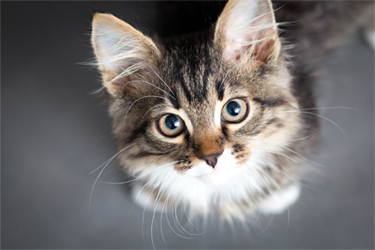Common Client Questions About Feline Birth Control
 When talking with clients about the responsibilities involved in owning a cat, a discussion on the prevention of pregnancy may arise. The following information focuses on questions and concerns that may be expressed by cat owners on the topic of birth control for their female cat.
When talking with clients about the responsibilities involved in owning a cat, a discussion on the prevention of pregnancy may arise. The following information focuses on questions and concerns that may be expressed by cat owners on the topic of birth control for their female cat.
What options are available for preventing conception?
The two procedures most commonly chosen to prevent a cat from becoming pregnant are:
- Ovariohysterectomy
- Tubal ligation.
Of these options, both have benefits and risks, but the ovariohysterectomy is the procedure most chosen by veterinarians.
What is an ovariohysterectomy?
An ovariohysterectomy is a surgical procedure also referred to as spaying. When a cat is spayed, the veterinarian removes the cat’s reproductive organs, consisting of the:
- Uterus
- Fallopian tubes
- Ovaries.
Are there benefits to spaying a cat?
Yes! The biggest health benefits to the animal include:
- Elimination of the chance she will develop:
- Cystic ovaries
- Uterine infections
- Uterine cancers
- Reduction in risk for developing mammary tumors.
Additionally, since spaying prevents the cat from coming into estrus (heat), the animal will no longer have the need to breed, which benefits both cat and owner. Aside from avoiding pregnancy, without the heat cycle:
- The female will not search for a male, which will help to keep the her at home
- Males will not be attracted to the female’s pheromones and calls, which will eliminate the reason for strays to hang around looking for an in-heat female
- The female will not be in breeding contact with unhealthy male cats, reducing the chance of contracting diseases.
What is a tubal ligation?
When given a tubal ligation, the cat is placed under anesthesia in order to have its fallopian tubes surgically cauterized or clamped. The purpose is to avoid pregnancy by preventing sperm from entering the uterus.
Tubal ligation:
- Carries almost the same risks as spaying
- Costs only slightly less
- Will not stop the cat from going into heat
- Does not offer the cat same benefits as spaying.
How old does a cat need to be before it can be spayed?
A good time to spay occurs when the cat is between 5 to 7 months old. Typically, animals of this age have not yet experienced their first heat. Spaying before the cat comes into its first heat cycle greatly reduces the animal’s chance for developing mammary tumors. In an effort to reduce the overpopulation of cats in animal shelters, veterinarians have been completing pediatric spays on kittens before they reach 2 months of age.
Are there any special instructions or precautions before or after surgery?
The veterinarian will provide information to follow once the appointment has been arranged. Prior to surgery, one important point to keep in mind is that the surgery requires the animal be put under general anesthesia, which may cause them to vomit and aspirate if they have a full stomach. As a general rule, the following steps will help to eliminate this problem:
- For older animals, withhold all food and water starting at midnight before the surgery
- If the animal is young and receiving a pediatric spay, do not fast the kitten for more than 3 to 4 hours before surgery.
Following surgery, the veterinarian will explain the steps to follow when the animal is picked up. If necessary, they may also provide pain medication, tips to follow to help keep her comfortable as she heals, and signs to watch for that indicate the need to contact the veterinarian.
These instructions may recommend you:
- Provide a quiet, warm, and darkened area for the cat to recuperate
- Restrict the cat’s movements to prevent the incision from opening and to protect the cat against a surgical hernia.
- Routinely check the incision to make sure:
- It remains closed and smooth, and that there is no sight of a hernia bump
- That it is healing properly, the skin remains pink, and it has not become infected
- That the cat doesn’t chew the area
- Watch to make sure the animal is eating and drinking once it is settled back at home.
Does spaying a cat make them fat and lazy?
Spaying may slow the metabolism of some cats, but if they become fat, the cause is more likely due to a lack of exercise and too much food.
Will spaying change the personality of my cat?
Basically, no. Some feel that spaying a cat helps to remove some annoying cat behaviors, for instance:
- Since spaying eliminates estrus, without the urge to breed, the cat will not be:
- Searching for a male to breed with
- Calling for a male to breed with
- Urine-marking because of being in heat
- Irritable during certain times of the year.
Spayed cats remain playful, retain their hunting instincts, and make good pets.
When taking on the ownership of a new pet, clients may not be aware of all of the responsibilities that come with bringing the animal home. Talking with them will help to clear up any questions and concerns.
Careers
Are you looking for a place to let your talents shine? At Covetrus, we help our practitioner customers better serve their patients and take pride in providing the best customer experience possible. Search our open positions to see our available opportunities.
Newsletter
Stay current with what’s going on with Covetrus, subscribe to receive our newsletter and email communications. Subscribers will receive the latest information in practice management, sales and marketing, animal health, and more.


Leave a comment